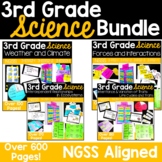3rd Grade Force and Motion Activities Balanced Unbalanced Forces Magnets NGSS
- PDF
What educators are saying
Also included in
- Are you struggling to find engaging science materials for your third grade NGSS lessons? These science units include so many activities and resources that you can use! There are mini books, vocabulary, posters, hands-on activities, passages, and so much more! This is a bundle of my four 3rd Grade NGPrice $38.00Original Price $56.00Save $18.00
Description
Are you looking for a fun way to teach 3rd grade force and motion? In this third grade science unit students will learn about push vs. pull, balanced and unbalanced forces, gravity, Newton's Three Laws of Motion, patterns in motion, friction, electric interactions, magnetic interactions, and how magnets can be used to solve problems. This third grade science unit has everything you need to engage your students and learn! There are many high interest activities that your students will love!
This third grade unit on force and motion aligns to NGSS* standards 3-PS2-1, 3-PS2-2, 3-PS2-3, 3-PS2-4 and many other state standards.
This unit includes so many activities and resources that you can use! There are mini books, vocabulary, posters, hands on activities, non-fiction passages, practice pages and so much more!
It covers four topics:
- Balanced and Unbalanced Forces
- Patterns in Motion
- Electric and Magnetic Interactions
- Magnetic Solutions to Problems
Download the 42 page preview to see what's included in this 140 page resource!
TEACHERS LIKE YOU SAID...
⭐⭐⭐⭐⭐I have loved using this reference with my class! It is very engaging and educational! It is a great resources to use in your classroom!
⭐⭐⭐⭐⭐Wow! This is a great addition to the Science curriculum. This resource will make the Science unit more engaging and save me time creating resources.
⭐⭐⭐⭐⭐These bundles have made teaching science so much easier! Love how little prep to no prep is required. Thank you for such a great resource!
⭐Save the most by purchasing the 3rd Grade Science BUNDLE! ⭐
It includes this unit and the following other units:
- 3rd Grade Weather & Climate
- 3rd Grade Interdependent Relationships in Ecosystems
- 3rd Grade Inheritance and Variation of Traits
*NGSS and Next Generation Science Standards are a registered trademark of Achieve. Neither Achieve nor the lead states and partners that developed the Next Generation Science Standards was involved in the production of, and does not endorse, this product.
©Thrifty in Third Grade
ALL RIGHTS RESERVED






